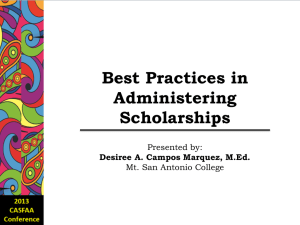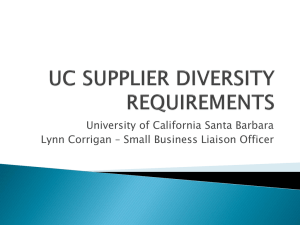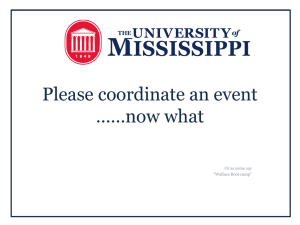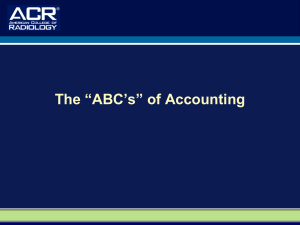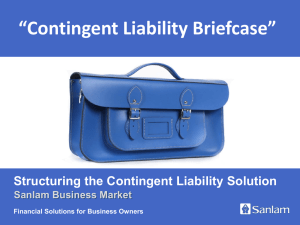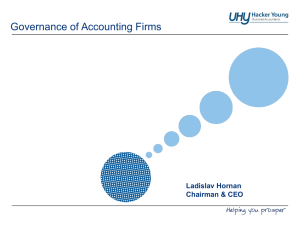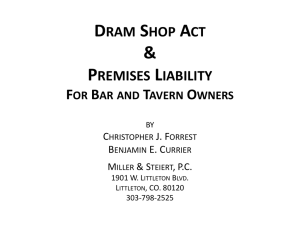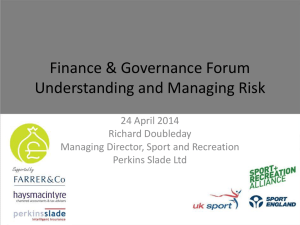Risk Assessment - Business & Financial Services
advertisement
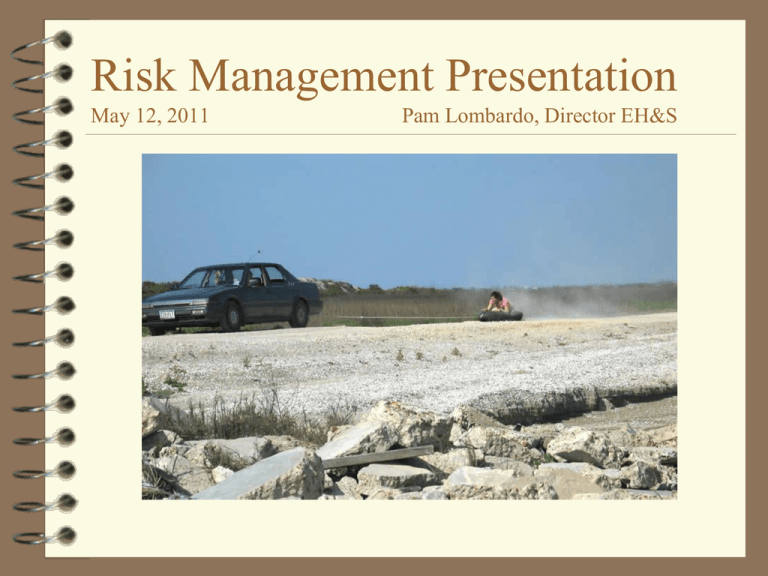
Risk Management Presentation May 12, 2011 Pam Lombardo, Director EH&S Risk Management Presentation Meeting Topics Section 1. Risk & the Risk Management Process Section 2. UC Insurance Programs & Policies Section 3. Risk & Contracts Section 4. Other Risk Transfer Techniques Section 5. Enterprise Risk Management Section 1 Risk & the Risk Management Process Definitions The Risk Management Process – Risk Analysis – Risk Financing – Elimination, Loss Control, Risk Retention – Risk Transfer Risk Management Flow Chart Section 1. Risk & the Risk Management Process Definitions Risk: – the potential that a chosen action or activity (including the choice of inaction) will lead to a loss; the possibility of loss or exposure to loss. Almost any human endeavor creates some risk. Risk Management: – a process that involves the identification, analysis and evaluation of risk and the selection of the best method of treating the risk. The objective of the risk management process is the protection of an organization’s financial, physical, and human assets from loss or destruction. Section 1. Risk & the Risk Management Process The Risk Management Process Define Objectives: What do you want to do and how will you do it. Risk Identification: Identify all potential loss exposures – an inventory of all possible human, physical, financial, and natural losses. Apply Risk Management Techniques: Analysis, financing, elimination, reduction, retention, and transfer. Section 1. Risk & the Risk Management Process Risk Analysis High Frequency Low Frequency High Severity Work to reduce and insure Insure Low Severity Work to reduce and insure Retain and self-insure Risk Analysis: How frequently will losses occur? How severe will they be? What are the total loss possibilities for a single risk occurrence? Section 1. Risk & the Risk Management Process Elimination, Loss Control, Retention Elimination: – The best solution, is to eliminate risk if possible. Loss Control: – take steps to avoid risk as much as possible, and implement policies and procedures that will reduce and prevent losses. Risk Retention: – After you made your best effort to eliminate and avoid risks, and taken steps that will reduce and prevent losses, you must analyze the remaining loss potential to whether it is small enough to retain or it is necessary to transfer. Section 1. Risk & Risk Management Process Risk Transfer Risk Transfer: – Insurance: • The University purchases insurance to cover the exposures that are caused by its operations and that cannot be retained, eliminated, or transferred to a vendor. Insurance is a risk transfer technique. – Indemnification or Hold Harmless Provision: • Requires a supplier, tenant, or contractor to assumes responsibility for liabilities caused by its own negligence; vendor provides evidence of insurance to demonstrate it has financial wherewithal to meet the indemnification obligation. – Waiver of Liability: • A document that requires a participant in an activity to hold the University harmless if injured in the activity. Section 1. Risk & the Risk Management Process Risk Management Flow Chart Define Objectives What are you trying to do and how will you do it? Risk Identification Manage Risks What are potential human, physical, financial & natural loss exposures? What are you doing to manage the risks – financing, elimination, loss control, retention, and/or risk transfer? Monitor Controls Are you monitoring key risk indicators and tracking efficacy of risk management techniques? Section 2 UC Insurance Programs & Policies UC Self Insurance Programs UC Excess Insurance Policies Commercial Insurance Policies Section 2. UC Insurance Programs & Policies Self-Insurance Programs The University of California has been self-insured since 1986. Self- insurance is a form of retained risk. UC decided that the cost of buying insurance was so high that it made sense to establish the following inhouse self-financed insurance programs: Workers Compensation Auto Liability General Liability Professional Liability Employment Practices Liability Property Insurance Section 2. UC Insurance Programs & Policies UC’s Excess Commercial Policies The University’s Self-Insurance programs provide coverage to certain limits, the selfinsured retention (SIR). Above the self-insurance programs, UC purchases excess commercial insurance policies. Excess insurance policies are a means of transferring risk. Section 2. UC Insurance Programs & Policies UC Commercial Insurance Policies UC does not self-insure all its exposures. It transfers the cost of risk of some by purchasing commercial policies that provide “first dollar” coverage: Aviation Boiler & Machinery Builder’s Risk Business Travel ICA & Club Sports Fine Arts & Collections Foreign General Liability Ocean Marine Off-Campus Student Travel Marine Open Cargo Special Events Section 3 Risk & Contracts What is a Contract? Types of Contracts Indemnification UC’s Standard Mutual Indemnification Provision Vendor Insurance UC’s Vendor Insurance Matrix Typical Vendor Insurance Requirements The Certificate of Insurance Waiver of UC Insurance Requirements Section 3. Risk and Contracts What is a Contract? Contract: A contract is a legally enforceable agreement between two (or more) parties to perform, or refrain from performing, some specified act(s) in exchange for lawful consideration. Contract Elements: – – – – – Offer Acceptance Consideration Terms (unambiguous) Signature of individuals authorized to enter into contract Section 3. Risk and Contracts Types of Contracts Facility Use Permits Professional Services Agreement Grants Research Access Permits Performance Agreements Academic, Instructional agreements Leases, Rentals Purchase Orders Section 3. Risk and Contracts Indemnification What is Indemnification? – A Contract provision that is a form of risk transfer, as it specifies who shall be financially responsible in the event of a loss. Regents' Standing Order 100.4(dd)(9): – Prohibits campuses from entering into agreements that contain indemnification provisions by which UC assumes liability for conduct of persons other than University officers, agents, employees, students, invitees, and guests. Section 3. Risk and Contracts Vendor Insurance Indemnification – is a Promise to Perform Vendor Insurance – is the Financial Wherewithal to Perform Section 3. Risk and Contracts UC’s Vendor Insurance Matrix http://www.ucop.edu/ucophome/policies/bfb/bus63-VendorMatrix.pdf Section 3. Risk and Contracts Typical Vendor Insurance Req’ts. GENERAL LIABILITY (contractual liability included) with minimum limits: a) Each Occurrence b) Products/Completed Operations Aggregate c) Personal and Advertising Injury d) General Aggregate $1,000,000 $2,000,000 $1,000,000 $2,000,000 BUSINESS AUTOMOBILE LIABILITY $ 1,000,000 CSL WORKERS COMPENSATION As req’d by State law ADDITIONAL INSURED: both the General Liability and Automobile Liability policies shall be endorsed to include The Regents of the University of California as additional insured. Section 3. Risk and Contracts The Certificate of Insurance Section 3. Risk and Contracts Waiver of UC Insurance Requirements Can UC Insurance Requirements Be Waived? It depends – can be waived when exposure to liability is determined to be negligible. What Is Critical to Determining If Exposures Are Negligible? We need to know what the final product is and how the vendor will accomplish the contract scope of work. The how and what is what creates the exposures. A Waiver Negates Risk Transfer. When a department requests a waiver of University insurance requirements it creates increased liability for the University. Waivers are granted on the condition that the department requesting the waiver assumes financial responsibility for any losses that arise out of the contract scope of work. Section 4 Miscellaneous Risk UC Waivers of Liability Campus Connexions Accident/Travel Insurance Section 4. Miscellaneous Risks UC Waivers of Liability protect the University from legal liability for injuries that may occur to individuals who participate in voluntary or required activities. a participant in an activity agrees to hold the University harmless if injured in the activity. commonly required for activities that create physical risk to the participants, e.g. sports activities, off-campus travel, boat charters, transportation, etc. Section 4. Miscellaneous Risks CampusConnexions Insurance for Affiliated Organizations: Registered Student Organizations Event Liability Policy Foundations, Alumni, and Support Groups Policies Tenant Users Liability Insurance Protection (TULIP) Recognized Club Sports Camps and Clinics Event Liability Policy Renters Insurance http://ucsb.marshcampusconnexions.com Section 4. Miscellaneous Risks Travel Accident Insurance The University’s Travel Accident Insurance Program: a travel insurance program for employees and students who are traveling out-of-state on University business or participating in University sponsored activities. The benefits are provided at no cost and include: – Out-of-Country Medical Expenses – Emergency Medical Evacuation – Repatriation of Remains – Security Extraction – Travel Assistance – Personal Property and Lost Luggage – Trips Interruption and Cancellation iJet/WorldcueTRAVELER: When University travelers register for travel accident coverage they will receive travel alerts about the country they are traveling in. The system also allows the University to keep track of and communicate with its employees and students in the event of an emergency. http://www.ucop.edu/riskmgt/uctrips/ Section 5 Enterprise Risk Management Definition Elements of Enterprise Risk Management Everyone is a Risk Manager Top 5 Risks at UCSB? ERM - Defined A risk-based approach to managing an enterprise – Integrates concepts of internal controls and strategic planning – Includes all stakeholders – Incorporates a broad spectrum of risks in complex organizations to ensure they are managed Section 5. Enterprise Risk Management Elements of Enterprise Risk Mgmt. Strategic Goals – The University’s mission is teaching, research and public service. Risk Assessment: Identify and assess risk in context of strategic goals, to identify changing risk trends, and to prioritize risk management. Risk Response: Develop a set of actions to mitigate risks. Control Activities: Establish and implement policies and procedures to help ensure risk responses are effectively carried out. Communication: Communicate risk management goals and activities, identify interrelations of risk factors across activities and units. Monitor: Develop and implement means to monitor key risk indicators, and report on processes for on-going risk management activities. ERM Flow Chart Section 5. Enterprise Risk Management Everyone is a Risk Manager MSO’s – Internal Controls, SAS 112 Internal Audit - Annual Risk Assessment General Counsel - Advice for Legal Matters, Manages Litigation Insurance - Workers’ Compensation, General Liability Insurance Compliance and Ethics Committee - Compliance with Laws, Ethics, Policies Student Affairs - Student Behavioral Health Team Athletics - NCAA Compliance Strategic Planning - Funding for Operations EH&S - Assess Safety and Hazards Information Security- HIPAA, IS-3 Design and Construction - Earthquake Assessment Research - Compliance with Grant Regulations, Laws Control Self-Assessment Questionnaire The Control Self-Assessment Questionnaire is a tool to be used by departments to assess the adequacy of the internal controls within their area. Departments are encouraged to conduct a self-assessment annually, or as needed with changes in administrative personnel. UCSB Policies and Procedures for Business Officers: http://www.policy.ucsb.edu/policies/specialty/admin Section 5. Enterprise Risk Management Top 5 Risks at UCSB Lab Safety Outdated Information Technology Systems Deferred Maintenance Inadequate Information Technology Funding Loss of Research Productivity as PI’s Teach Classes Risk Management Presentation Questions? Section 6. Campus Contact Information Contacts Lee Mudrick, Insurance Administrator – Tel. 893‐2860; Email: lee.mudrick@ehs.ucsb.edu Kathy Speer, Insurance Coordinator – Tel. 893‐5837; Email: lee.mudrick@ehs.ucsb.edu Kimberly Tapia, Contracts Manager – Tel. 893-5836; Email: kimberly.tapia@contracts.ucsb.edu Daniel Sweeney, Contracts Analyst – Tel. 893-2271; Email: daniel.sweeney@contracts.ucsb.edu Ron Betancourt, Contracts Assistant – Tel. 893‐4670; Email: contracts@contracts.ucsb.edu Carrie Frandsen, Enterprise Risk Management – Tel. 893-3154; Email: carrie.frandsen@ehs.ucsb.edu Risk Management Takes a Village http://www.riskmanagement.ucsb.edu


